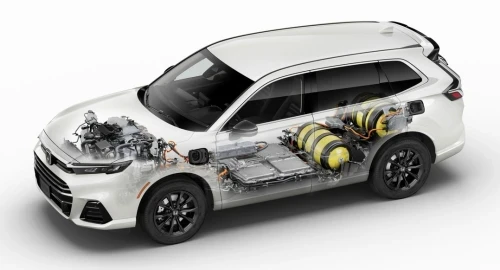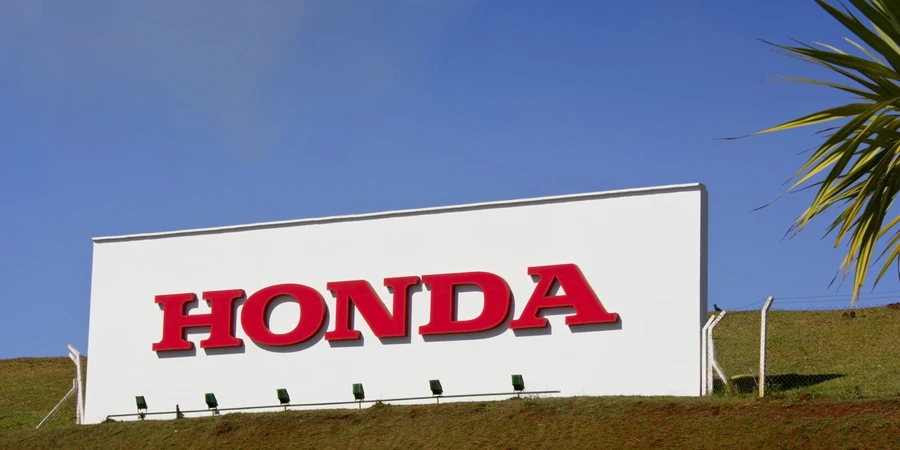Honda revealed the US’ first production plug-in hydrogen fuel cell electric vehicle, the 2025 Honda CR-V e:FCEV. With a 270-mile EPA driving range rating, CR-V e:FCEV combines an all-new US-made fuel cell system along with plug-in charging capability designed to provide up to 29 miles of EV driving around town with the flexibility of fast hydrogen refueling for longer trips. The vehicle has a 17.7 kWh battery pack.

The 5-passenger CUV is the first application of the second-generation Honda Fuel Cell Module, which is produced at Fuel Cell System Manufacturing, LLC (FCSM) in Michigan, offering improved durability, higher efficiency, increased refinement and lower cost compared to Honda’s previous generation fuel cell system.
Co-developed with General Motors (GM), the next-generation Honda Fuel Cell Module leverages the knowledge, know-how and economies of scale of both companies and will reduce the cost by two-thirds compared to the cost of the fuel cell system in the Honda Clarity Fuel Cell. This significant cost reduction was achieved by various measures including the adoption of innovative materials for electrodes, advancement of a cell sealing structure, simplification of the supporting equipment and the improvement of productivity.
Moreover, the durability of the system has doubled by the application of corrosion-resistant materials and controlled suppression of deterioration, and low temperature performance was also improved significantly.
The 2025 CR-V e:FCEV features a front-mounted single-motor producing 174 horsepower and 229 lb.-ft. of torque for quick acceleration and maximum efficiency.
Honda engineers have optimized the CR-V e:FCEV structure and suspension to deliver the same driving experience and refinement as other CR-V models. Compared to CR-V turbo and hybrid models, rear lateral rigidity is increased 10%, rear torsional rigidity has improved 9% and its MacPherson strut front suspension and multilink rear suspension have been completely retuned with specific springs, amplitude-sensitive dampers and stabilizer bars front and rear to optimize responsiveness while maintaining a smooth ride.
The driver can customize the driving experience with four selectable drive modes: Normal, Eco, Sport and Snow.
Standard features include HondaLink with expanded capabilities including hydrogen station information in addition to charging and power supply data. For additional convenience, the included Honda Power Supply Connector utilizes a 110-volt power outlet that can deliver up to 1,500 watts of power, turning CR-V e:FCEV into a clean power source capable of running small home appliances, portable air conditioners, power tools, camping equipment, and more.
The 2025 Honda CR-V e:FCEV will be available for customer leasing in California beginning later this year.
Leveraging Honda fuel cell technology expertise continues to play a critical role in our global goal to achieve carbon neutrality for all products and corporate activities by 2050. Honda has laid out an electrification strategy leading to 100% zero-emission automobile sales by 2040, including the introduction of both battery-electric and fuel cell electric vehicles like this new CR-V e:FCEV model.
—Mamadou Diallo, senior vice president of Auto Sales, American Honda Motor
The CR-V e:FCEV is built at Honda’s Performance Manufacturing Center in Marysville, Ohio, and is the only fuel cell electric passenger vehicle made in the US.
Fuel cell application roadmap. Honda has identified four core domains for the initial utilization of its new fuel cell system: FCEVs, commercial fuel cell vehicles, stationary power stations and construction machinery. While initial FCSM production will be used in support of Honda internal initiatives and FCEV sales, Honda is exploring external fuel cell business opportunities with a goal to begin external deliveries of the fuel cell system modules in the near future. The company envisions initial sales of 2,000 units per year and then expanding sales in stages.
Honda began demonstration testing of a stationary fuel cell power station on its Torrance, Calif. campus in March 2023, marking the company’s first step toward future commercialization of zero-emission backup power generation. The fuel cell power station supplies clean and quiet emergency backup power to Honda’s data center. In December 2023, Honda also announced a similar joint project in Japan where Honda will establish a stationary fuel cell station to power a Mitsubishi data center.
Backup power systems utilizing hydrogen fuel cells offer a promising future for clean, yet reliable and high-quality power generation, especially when operating on green hydrogen made from renewable sources, with water vapor as the only emission.
Future stationary fuel cell (FC) units intended for commercialization will utilize the new Honda FC system. In the coming years, Honda will begin applying stationary FC power station technologies now under development—featuring a next-generation FC system with further cost reduction and improved performance—to Honda facilities and data centers globally.
In the area of commercial vehicles, the GIGA FUEL CELL, a zero-emissions fuel cell-powered heavy-duty truck currently being co-developed by Isuzu Motors Limited and Honda Motor Co., Ltd. was shown for the first time at the Japan Mobility Show 2023.
In addition to conducting joint research on fuel cell heavy-duty trucks, the two companies have begun demonstration testing of a prototype model on public roads in Japan in December 2023, and plan to introduce the production model to market in 2027 by fully leveraging the technology, experience and knowledge gained through the joint research.
Moreover, Honda is preparing a proof-of-concept Class 8 hydrogen fuel cell truck in the US and is in talks with potential customers.
Honda also will take initiative to apply its fuel cell system to construction equipment such as excavators and wheel loaders, contributing to the realization of carbon neutrality for construction machinery.
Honda is conducting advanced research and development of hydrogen technologies while envisioning use in outer space, another potential area where hydrogen technologies such as a fuel cell system and high differential pressure water electrolysis technologies can be utilized. In addition to water and food, people need oxygen, as well as hydrogen for fuel and electricity for various activities supporting life in space.
Source from Green Car Congress
Disclaimer: The information set forth above is provided by greencarcongress.com independently of Alibaba.com. Alibaba.com makes no representation and warranties as to the quality and reliability of the seller and products.




